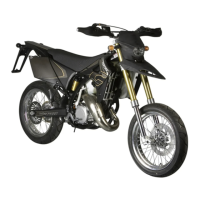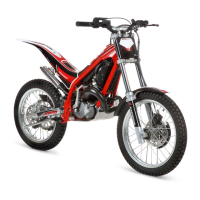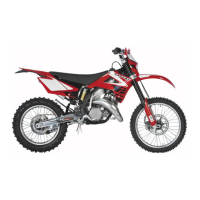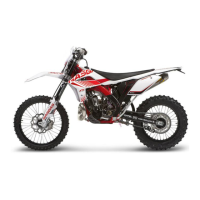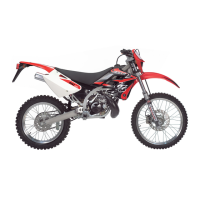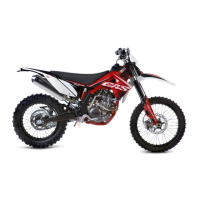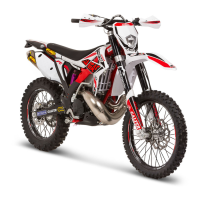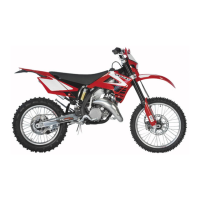Do you have a question about the GAS GAS EC450 2009 and is the answer not in the manual?
Details about the engine, displacement, bore, stroke, and fuel supply.
Information on transmission type, clutch, gear ratios, and oil.
Chassis type and front/rear tyre sizes.
Details on front and rear suspension, stroke, oil, and air pressure.
Information on brake type and effective disk diameter.
Overall height, length, width, wheelbase, ground clearance, fuel capacity, and weight.
Identifies key components on the EC 450/515 handlebar area.
Identifies key components on the EC SM 450/515 handlebar area.
Instructions for deploying and securing the side stand for safe operation.
Details on fuel tank capacity and how to open/close the fuel cap.
Details on minimum octane ratings (Antiknock Index and Research Octane No.).
Information on where to find the serial number on the steering tube.
Details about the qualification approval plate and its data.
Steps to turn on the electrical circuit and start the engine using the start button.
Steps to stop the engine by changing to neutral and cutting the gas.
How to start a cold engine using the dedicated function without throttle.
Instructions for engaging gears, including shifting from neutral to first.
How to decelerate using throttle and brakes, and disengaging the clutch.
Detailed steps for the initial break-in period to ensure proper engine and transmission operation.
Chart detailing inspection, tightening, and cleaning tasks for various components at different intervals.
Steps for removing the battery and operating instructions for charging it.
Instructions for checking radiator hoses for damage and obstructions in the radiator fins.
Explains the role of coolant, anti-freeze, and warnings for handling.
Procedures for checking coolant level and important safety precautions.
Step-by-step guide on how to change the engine coolant, including draining and refilling.
Details on the type of coolant and mixture ratio for optimal performance.
Specifies the tightening torque for the water pump plug.
Instructions for inspecting, cleaning, and replacing the spark plug based on condition and hours.
Step-by-step guide to safely remove the spark plug from the engine.
Explains the importance of the air filter and risks of obstruction.
Detailed steps for cleaning the air filter safely and effectively.
Instructions for checking and adjusting the play in the throttle grip for smooth operation.
Steps to adjust the clutch lever play for optimal engagement and wear.
Procedure for replacing or servicing the motorcycle's silencer.
Instructions for inspecting the chain guide for wear and ensuring proper chain lubrication.
How to check the drive chain slack and adjust it for proper operation and safety.
Detailed steps for loosening the axle nut and adjusting chain tension using adjusting bolts.
Guidance on checking chain, sprockets, and pinion for wear and damage.
Inspecting the chain guide slide on the swing arm for wear and replacement.
How to inspect the drive chain wear guide for damage and replace if necessary.
Inspecting pinion and sprocket teeth for wear or damage and replacing them.
Importance and method of lubricating the drive chain, especially after wet riding.
Steps to adjust the handlebar position for rider comfort and riding style.
Explains that disc and pad wear is automatically compensated, with no adjustments needed.
How to adjust the front brake lever for comfortable reach and responsiveness.
Steps to adjust the rear brake pedal play to the specified 10mm for correct operation.
Recommendations for checking and periodically changing the brake fluid.
Specifies the recommended brake fluid types, DOT 3 or DOT 4.
How to inspect brake fluid levels and check brake pad thickness for wear.
Ensuring the steering is adjusted for free turning without excessive play.
Steps to check for loose steering and adjust components like the steering stem nut.
Instructions on how to use the steering lock mechanism to secure the handlebars.
Overview of the five stages of front fork adjustment: air pressure, compression, rebound, preload, and oil level.
How to adjust the rebound damping on the front forks using the extension control.
Steps to adjust the compression damping on the front forks.
Procedure for checking and adjusting the oil level in the front forks.
Information on selecting and using different front fork springs for desired performance.
How to ensure correct suspension plate position for tyre clearance.
Description of the rear suspension system and its adjustability.
Instructions for adjusting the rebound damping on the rear shock absorber.
Instructions for adjusting the compression damping on the rear shock absorber.
Steps for adjusting the rear suspension spring preload.
Information on replacing the rear shock absorber spring with stiffer or softer options.
Guidance on adjusting tyre pressure based on track conditions and rider preference.
How track conditions like wet, muddy, or stony terrain affect tyre pressure.
Instructions for checking spoke tension and centering the rim for wheel integrity.
Steps to prepare the motorcycle before washing, protecting sensitive areas.
Warnings about spraying water near specific components and avoiding brake disc contamination.
Actions to take after cleaning, including lubrication and brake checks.
Emphasizes the importance of checking all bolts and nuts daily for proper tightening and condition.
A table listing specific torque values for various motorcycle components.
Points on the motorcycle requiring lubrication, including levers and pedals.
Instructions for lubricating the chain and checking engine oil level.
Procedure for changing the engine oil and filter, including safety precautions.
Discusses factors like rider weight, skill, track conditions, and break-in period for tuning.
Explains how fork oil level impacts fork stiffness and bottoming resistance.
Lists common front fork stiffness issues and their potential causes and solutions.
Identifies rear shock stiffness issues and their corresponding causes and remedies.
Guidance on making adjustments based on rider weight, ability, and surface type.
How rider experience and weight influence spring choice for suspension tuning.
Adjusting suspension based on track conditions like corners, jumps, or sandy terrain.
Procedure to ensure front and rear suspension are balanced for optimal handling.
Addresses issues like front end searching or knifing, indicating soft forks.
Solutions for front forks not responding to potholes or diving excessively.
Solutions for rear end kicking, tire hook-up problems, and bottoming issues.
How to select the correct gear development by changing the rear sprocket for different track types.
Importance of keeping the air filter clean in dusty environments.
Precautions for wet conditions, mud accumulation, and radiator overheating.
A checklist of 29 items to verify before or during competition.
A list of 14 checks to perform after a day of competition.
Specific maintenance for dusty terrain, focusing on crankshaft wear.
Maintenance tasks after riding in muddy conditions, including greasing and inspections.
Steps to prepare the motorcycle for storage, including cleaning, draining fluids, and protection.
Steps to take to put the motorcycle back into service after it has been stored.
Overview of the display's capabilities, LEDs, and information shown on screen.
Detailed technical specifications for the multifunction display functions like speed, RPM, distance, and time.
Explanation of RPM bar, digital tachometer, speedometer, and maximum speed display functions.
Details on distance travelled (TRIP), odometer, and time counters (ART, RT).
How the gear change indicator and RPM warnings function.
Steps to enter setting mode and change speed units.
Procedures for setting wheel circumference and time format (12/24 hr).
How to set the display time and pulse per revolution for RPM.
Configuring temperature units, danger/warning temperatures, and gear change RPM.
Information on total display reset and internal battery replacement.
Explains the three different screens and how to navigate between them.
Information on display brightness, battery power, and lighting connection.
How the display enters sleep mode when inactive.
Two methods for measuring the wheel circumference for display calibration.
Troubleshooting for starter motor not working or engine not rotating.
Solutions for engine not starting, running roughly, overheating, or stopping.
Troubleshooting for abnormal noise, exhaust problems, and gear engagement faults.
Solutions for gears jumping, clutch slipping, and suspension hardness.
Troubleshooting for pulling, brake malfunction, and lighting system faults.
Details on the warranty provided by GASGAS, its duration, and coverage.
Conditions for warranty rejection, excluded items, and general provisions.
| Year | 2009 |
|---|---|
| Manufacturer | GAS GAS |
| Model | EC450 |
| Category | Motorcycle |
| Displacement | 449.3 cc |
| Compression Ratio | 12.5:1 |
| Fuel System | Carburetor |
| Cooling System | Liquid-cooled |
| Transmission | 5-speed |
| Front Brake | Single disc |
| Rear Brake | Single disc |
| Seat Height | 940 mm |
| Engine Type | Single cylinder, 4-stroke |
| Ignition | CDI |
| Rear Suspension | Monoshock |
| Fuel Capacity | 9.5 L |
| Bore x Stroke | 95.0 x 63.4 mm |
